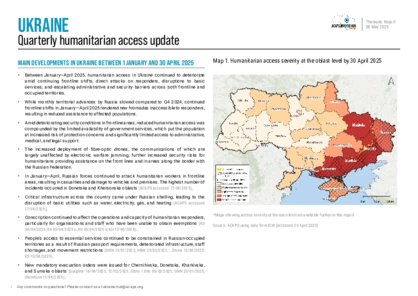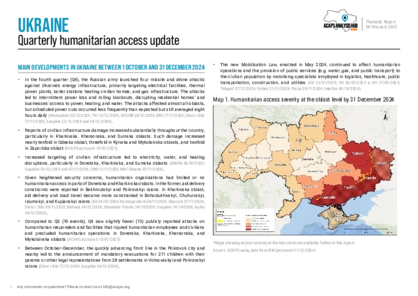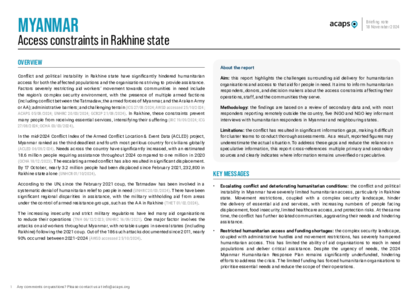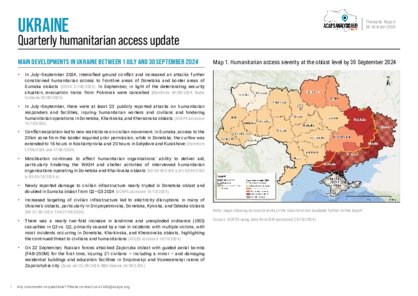The Global Humanitarian Access Overview is ACAPS’ twice-yearly assessment of the barriers that prevent aid from reaching people in crisis and people in crisis from receiving assistance.
The July 2025 edition examines bureaucratic and administrative impediments. These include registration requirements, restrictions on staff movement, customs and import procedures, financial controls and demanding reporting rules.
Key findings
Bureaucratic and administrative impediments are becoming a major barrier to humanitarian access, especially in politically fragmented and legally unstable environments.
These measures are not neutral administrative processes. Governments, de facto authorities and other actors often use them deliberately to control humanitarian operations and limit the space for action.
Conflicting demands from different authorities create legal uncertainty, break down coordination and stall frontline operations.
Between December 2024 and May 2025, crisis-affected populations in 36 countries experienced high to extreme access constraints that made it difficult for them to meet their basic needs.
SEVERE ACCESS
CONSTRAINTS
Access scores show a deterioration in 33% of the crisis-affected countries (26 countries) and an improvement in 16% (13 countries), while the humanitarian access situation remained stable for 51% (41 countries).
This distribution, which is consistent with those observed in previous months, underscores the persistence of high to extreme levels of humanitarian constraints (3–5) in 45% of crisis-affected countries.
WHAT IS THE HUMANITARIAN ACCESS SITUATION ACROSS THE GLOBE?
Disclaimer: some countries with active humanitarian crises might score 0 in ACAPS' Humanitarian Access Index in two instances: 1) the crisis emerged after the December 2024 issue of the index - in that case, the score is automatically 0, in the absence of data/historical data; 2) the actual score is 0 because no humanitarian access constraints were reported.
HUMANITARIAN ACCESS SCORES over time
SOUTH SUDAN
South Sudan saw a score increase to 5, recording extreme access constraints from December 2024 to May 2025. This deterioration is mainly the result of violence against aid workers and assets, aid diversion and confiscation, and bureaucratic constraints, such as considerable delays in obtaining clearance for the movement of certain relief items.
Extreme constraints persist in Burkina Faso, Myanmar, Palestine, Somalia, South Sudan, Sudan, Ukraine, and Yemen as a result of escalating conflicts amid growing bureaucratic and physical restrictions for humanitarian responders.
Between December 2024 and May 2025, humanitarian access across crises continued to be challenged especially by physical constraints, such as damage to roads and bridges, and violence affecting access to services, particularly in countries affected by conflicts or natural hazards.
This overall trend remained stable over the reporting period and is explained by the frequency of extreme weather events in countries already experiencing significant humanitarian access constraints given poor road infrastructure and remote locations, often in contexts of armed conflict.
Movement restrictions, administrative and bureaucratic constraints, and interference by authorities and non-state armed groups in humanitarian activities remained prevalent across crises, hampering or delaying the response.
In countries with high numbers of refugee and migrant populations, such as Egypt and Tunisia, restrictive administrative measures imposed by authorities continued to complicate access to services for people on the move.
Burkina Faso, Democratic Republic of Congo, Ethiopia, Haiti, Myanmar
Intensified violence and blockades, critical infrastructure damage, and movement restrictions continued to limit access to people in need of humanitarian aid. High levels of humanitarian need persist in these countries because of protracted conflicts, often compounded by climate hazards.
HOW ARE THE ACCESS LEVELS BEING CALCULATED?
Our methodology groups 9 indicators under 3 pillars: each indicator is given a score from 0–3 and X when there is an information gap. The model then combines the indicators in pillars, where they get a final score on a scale of 0–5.
PILLAR 1: ACCESS OF PEOPLE IN NEED TO HUMANITARIAN AID
indicators under PILLAR 1
1: Denial of existence of humanitarian needs or entitlements to assistance
2: Restriction and obstruction of access to services and assistance
Burkina Faso, Lebanon, Syria
39% of the crisis-affected countries in the ACAPS Global Humanitarian Access Index scored 3–5 for this pillar. The majority of these countries faced protracted crises marked by the denial of entitlement to assistance to some affected groups, often by both state and de facto authorities, and movement restrictions imposed by the authorities, national armed forces, or non-state armed groups, hampering the ability of affected people to access aid. Conflict and international displacement were the main drivers of the crises scoring 3–5 for this pillar.
Since October 2023, Israeli military operations in Palestine, especially in Gaza, have resulted in extremely high access restrictions and unprecedented violence against humanitarian personnel, facilities, and assets, as a result of direct and indirect attacks.
PILLAR 2: ACCESS OF HUMAnITARIAN RESPONDERS TO PEOPLE IN NEED
indicators under PILLAR 2
3: Impediments to enter the country
4: Restriction of movement within the country
5: Interference into implementation of humanitarian activities
6: Violence against humanitarian personnel, facilities, and assets
Cameroon, Democratic Republic of Congo, Myanmar
28% of the crisis-affected countries in the ACAPS Global Humanitarian Access Index scored 3–5 for this pillar. These were mainly countries facing protracted conflicts, with a stable global access score ranging from 3–5, that across the years have tended to record frequent incidents of violence against humanitarians and recurrent or systemic obstruction and interference in the implementation of humanitarian activities by both state and de facto authorities.
Humanitarian access in Afghanistan remains greatly restricted owing to a combination of factors, including administrative and bureaucratic obstructions, a volatile security situation, and physical and environmental constraints.
PILLAR 3: PHYSICAL, ENVIRONMENTAL AND SECURITY CONSTRAINTS
Indicators UNDER PILLAR 3
7: Insecurity or hostilities affecting humanitarian assistance
8: Presence of landmines, improvised explosive devices, explosive remnants of war and unexploded ordnance
9: Physical constraints in the environment
Afghanistan, Chad, Haiti
73% of the crisis-affected countries in the ACAPS Global Humanitarian Access Index scored 3–5 for this pillar, the highest percentage across all pillars. The crises concerned are mainly those driven by conflict and/or natural hazards, where obstacles to humanitarian access related to terrain, weather conditions, and lack of or poor critical infrastructure have been observed.
learn more about our methodology
Analysis products
on
Humanitarian access overview
08 May 2025
Ukraine: quarterly humanitarian access update (Q1 2025)
DOCUMENT / PDF / 9 MB
This report compares access challenges across Ukrainian oblasts and raions to inform humanitarian responders and support decision-making. It is part of the ACAPS regular analysis of access constraints, with the latest report published on 6 February 2025.
Attached resources
06 February 2025
Ukraine: Quarterly humanitarian access update (Q4 2024)
DOCUMENT / PDF / 9 MB
This report compares access challenges across Ukrainian oblasts and raions to inform humanitarian responders and support decision-making. It is part of the ACAPS quarterly analysis of access constraints, with the latest report published on 28 October 2024.
Attached resources
18 November 2024
Myanmar: access constraints in Rakhine state
DOCUMENT / PDF / 284 KB
This report highlights the challenges surrounding aid delivery for humanitarian organisations and access to that aid for people in need. It aims to inform humanitarian responders, donors, and decision makers about the access constraints affecting their operations, staff, and the communities they serve.
29 October 2024
Ukraine: quarterly humanitarian access update (Q3 2024)
DOCUMENT / PDF / 4 MB
This report compares access challenges across Ukrainian oblasts to inform humanitarian responders and support decision-making. It is part of the ACAPS quarterly analysis of access constraints, with the previous report published on 29 July 2024.
Attached resources
05 August 2024
Humanitarian Access Overview - July 2024
DOCUMENT / PDF / 3 MB
This overview compares the overall level of humanitarian access between the last Global Humanitarian Access Index published in December 2023 (covering June–November 2023) and this latest ACAPS assessment (covering December 2023 to June 2024) published in July 2024.








